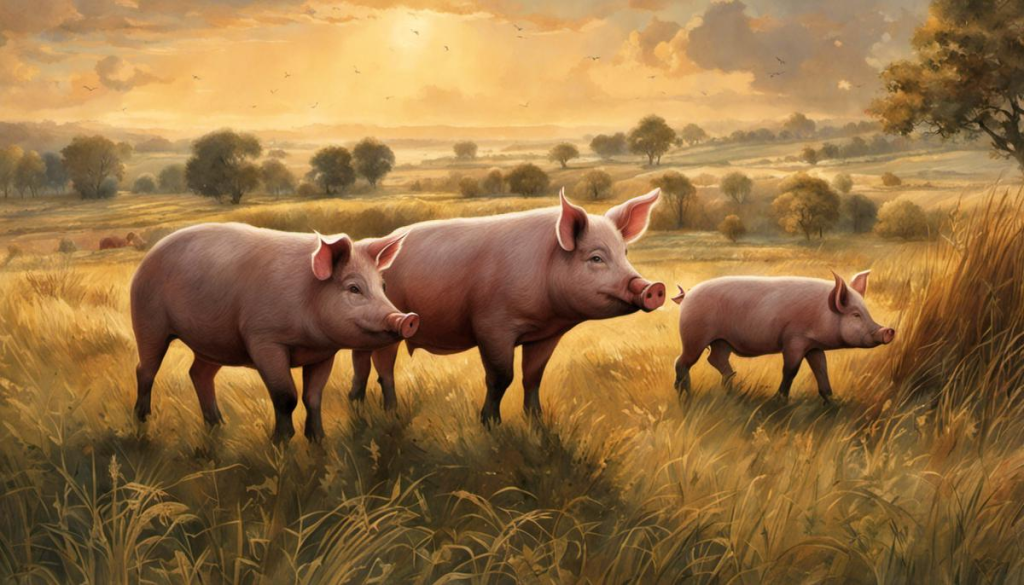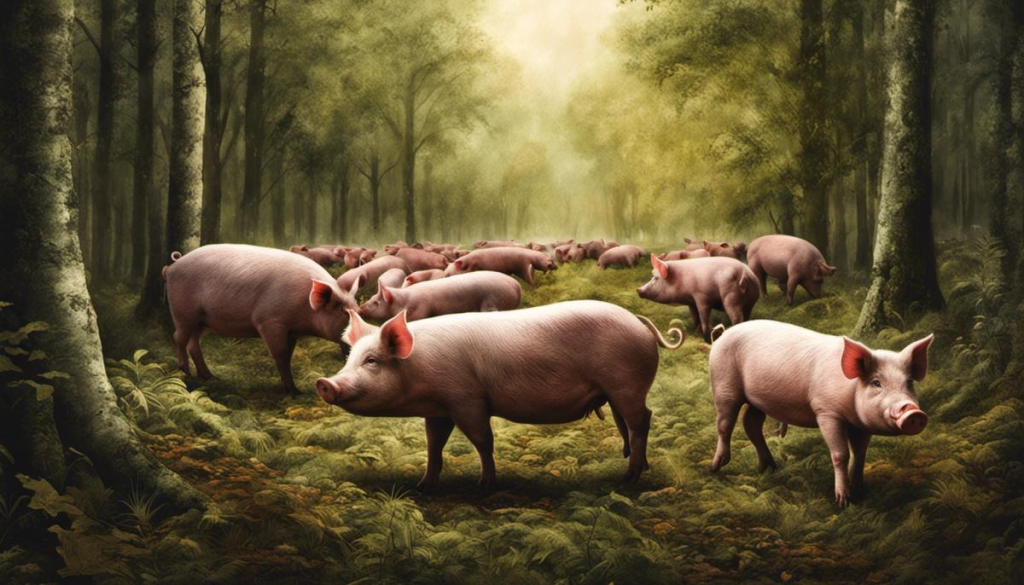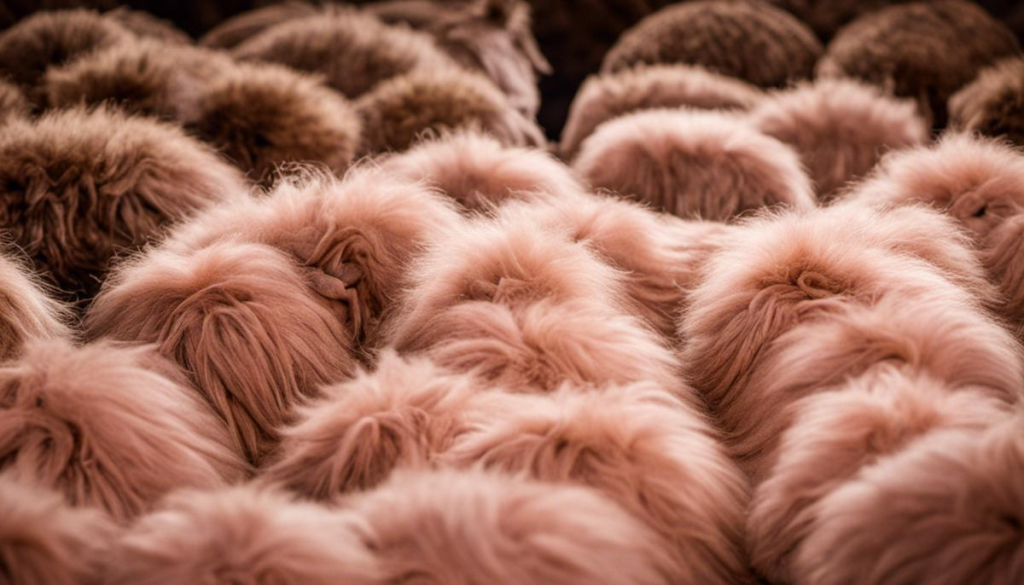The centrality of pigs in the fur industry is a curious study of both history and practicality. Over the centuries, different breeds of pigs have been strategically used for their unique contribution to the production of various types of fur materials. Furthermore, as crucial as these domesticated animals are to the fur industry, their usage is not without a recognisable impact on the environment. The rapid expansion of pig farming and fur production procedures have led to noticeable shifts in biodiversity, increases in carbon footprints, and the generation of waste. On an economic scale, the use of pigs in the fur industry presents a mix of benefits and drawbacks. Added to this complexity is the ethical dimension, a highly contentious element due to the challenges it presents to animal rights and society’s views on the usage of pigs for fur production.

Pigs in the Fur Industry
Pigs in the Iron Age and Fur Insulation
Historically, during the Iron Age, pigs were one of the main animals to be domesticated and were utilized for various uses, including their fur. The fur of pigs was considered a valuable resource and was widely used for insulation purposes. Pig’s fur was found to retain heat remarkably well, providing warmth during the cold winter season. Thus, pig’s fur became an essential material in the production of various items such as winter clothes, bedding, and upholstery.
Pig Breeds Used in the Fur Industry
There are several breeds of pigs which were commonly used in the fur industry. Among them are the Wild Boar and the Mangalica, both providing thick and wooly fur. This shaggy fur was especially prized for its warmth and durability. The fur of these pigs, referred to as ‘bristles’, has extremely thick and coarse properties making it resilient to wear and tear. The Mangalica, a Hungarian breed, is often compared to sheep for its woolly fur. Meanwhile, the Wild Boar, with its double layer fur, offered both coarse guard hairs for protection and a softer undercoat for insulation. These specific qualities made these breeds highly sought after in the fur industry.
Mangalica Fur and its Unique Properties
The Mangalica pig has a thick fur coat known as ‘fleece,’ which is curly and closely resembles sheep’s wool. This coat is unique as it provides protection from the elements and helps the pig stay warm in freezing temperatures. As a result, the Mangalica pig’s fur has been widely used in creating insulative materials and clothing.
Wild Boars and High-Quality Bristles
The fur of Wild Boars is considered high-quality due to its thickness and density. These powerful and sturdy bristles have been widely used in clothes and other textile industries. Coarse boar bristles have also found use in brushes, from hairbrushes to industrial brushes.
Modern-Day Fur Industry
In the modern fur industry, pig fur is less commonly used due to ethical concerns around animal welfare. However, synthetic furs designed to mimic pigs’ bristle characteristics have been formulated as a more humane option. Nonetheless, boar bristles are still in high demand for the production of high-quality brushes due to their exceptional thinness and rigidity.
Sustainability Factors
The use of pigs can also be seen as contributing to sustainability within the fur industry. Unlike minks or foxes, pigs are not raised solely for their fur but are a source of food as well. This dual-purpose use reduces waste and makes pig farming a more sustainable operation.
The Significance of Pigs in the Fur Industry
Pigs have a noteworthy role in the fur industry with their contribution being diverse and impactful. Particular breeds of pigs, such as the Mangalica and the Wild Boar, offer a unique type of fur that surpasses others in some characteristics. These breeds have had a lasting influence on the industry, even amidst the rising trend of synthetic alternatives. As the fur industry continues to evolve, the important role of pigs underlines the necessity for sustainable and diverse sourcing of materials.

Environmental impact of using pigs in the Fur Industry
Environmental Impact: Biodiversity Reduction and Carbon Footprint Increase
The utilisation of pigs in the fur industry has significant environmental implications, primarily in the form of biodiversity loss and an expanded carbon footprint. Large areas of land are required for farming pigs, particularly for their leather which is a secondary product of the meat industry. This leads to deforestation and habitat destruction. This land is required for the pigs and also for the cultivation of their feed, which has negative implications for biodiversity as forests are cleared.
Contributions to Waste and Water Pollution
A considerably large amount of waste is generated from pig farming for fur. Inadequately managed waste, which includes manure and other byproducts, can cause soil and water pollution. For instance, pig manure has high levels of nitrogen and phosphorus which may leach into water systems, causing harmful algal blooms, leading to a condition known as eutrophication. Moreover, pig farming can lead to overexploitation of water resources for both their daily sustenance and crop irrigation.
Sustainable Approaches and Damage Control
Despite the associated environmental impacts, there are ways to minimize the damages caused through pig farming in the fur industry. This includes the incorporation of sustainable farming practices. With improved waste management, the likelihood of soil and water pollution can be significantly reduced. For instance, repurposing animal waste as fertilizer could serve as a viable solution.
Several policies and methods can be put into practice to lower the carbon emissions in pig farming. This could involve implementing farming methods which reduce deforestation and minimize the dependence on carbon-intense animal feed. This can be achieved through environmentally-friendly feeding strategies, such as creating a diet tailored to the specific growth stage of the pig, thereby decreasing the quantity of feed required and the corresponding emissions.
Ultimately, a balance has to be struck between the demand for pig fur products and the resulting environmental repercussions. With consumers being more mindful – choosing sustainably sourced fur or alternatives to fur – the ecological footprint of the industry could potentially be reduced significantly.

Economic impact and ethical considerations
Assessing the Economic Implication of Pig Usage in the Fur Industry
The fur industry, while lucrative, generates billions of dollars globally and acts as a critical player in the world economy. However, the contribution attributed to pig fur remains relatively marginal. A chunk of the European Union, with its longstanding tradition of utilizing pigskin for leather, finds it essential. While animal fur, inclusive of pig fur, finds a place in the fashion and décor industries, its market share remains limited due to the presence of alternatives and growing public awareness towards animal rights.
Cost vs. Profit Considerations
Raising pigs for fur can have both economic benefits and detriments. While raising pigs can potentially enable farmers to diversify their income streams, the costs associated particularly with fur farming can outweigh the potential profits. This provision is especially accentuated given the stringent regulations imposed on biosecurity, animal health, and welfare. Notably, fur processing is a costly affair. It requires specialized machinery for skinning, treatments for preserving the fur, and labor, decreasing its profitability relative to other livestock products.
Moreover, the increasing public demand for faux fur items, mainly attributed to animal welfare concerns, has lowered the demand for pig fur, adversely affecting its market value.
Ethical Considerations and Animal Rights Issues
The use of pig fur in the fur industry raises significant ethical issues. Animal rights advocates argue against fur farming due to concerns about the inhumane treatment and living conditions of animals, including pigs, in these facilities. Moreover, there are concerns about the slaughtering processes, which may inflict unnecessary suffering on the animals. Various animal rights organizations actively campaign against fur farming, urging companies and consumers to opt for cruelty-free and sustainable alternatives.
Public Sentiment and Changing Consumer Preferences
Public sentiment significantly influences the use of pig fur in the industry. Increasing awareness about animal rights and activists’ efforts have led to a shift in consumer purchasing behavior, with more consumers choosing faux fur over real fur. This trend has urged multiple big-name fashion houses, retailers, and designers to ban the use of real animal fur in their products as a way to appeal to conscious consumers. Additionally, government policies banning fur farming in several countries have reflected this change in attitudes and concern for animal welfare.
In conclusion
The use of pigs in the fur industry has a varied impact, with limited economic benefits and growing ethical issues. These factors contribute to the declining demand for real pig fur in the marketplace.

Yet, amid these multifaceted impacts, several efforts are being shaped towards sustainable practices within the industry. Besides, deeper understanding of the diverse roles and intricate relationships between pigs and the fur industry invites us to take a more nuanced view of this global sector. The fur industry, notably its heavy reliance on pig farming, taps into broader discourses on environmental responsibility, global economies, and ethical obligations. As society’s views evolve, so too must our understanding and approach to the broad-reaching implications of our shared engagement with the fur industry. Given the complexities, acknowledging and framing these considerations and impacts is crucial for fostering future discussions and shaping the industry’s path forward.